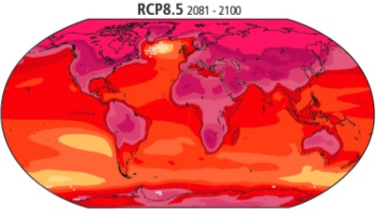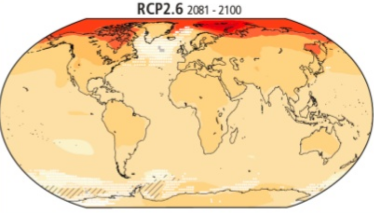
Are we heading for a radically altered, roasty-toasty, potentially unlivable planet? Or might we make choices to steer toward a future Earth that is warmer than today but much more livable than the hot-house version? And given such starkly different scenarios, how do we convey the risks and responses to people who will ultimately shape the future, like the 76 million Americans now in school?


To convert from the above degrees Celsius to degrees Fahrenheit, multiply by 1.8.
As IPCC lead author Chris Field suggested at a recent conference on water and climate, we could adapt to the latter scenario, but the former would surely wreck human civilization (my words, not his.)
This stark choice distills the essential dichotomy of climate change: either we get serious about addressing climate change (and increase our odds of surviving and thriving) or we continue doing business as usual, burning fossil fuels and using the atmosphere and ocean as a dump for heat-absorbing gases.
The recently leaked draft of the Summary for Policymakers of the Intergovernmental Panel on Climate Change Fifth Assessment Report for Working Group II on Impacts, Adaptation, and Vulnerability includes several graphics, including the maps above and graph below.

The maps depict the red-hot route, referred to as RCP8.5 and the lukewarm route, known as RCP2.6. (RCP stands for Representative Concentration Pathway. RCP8.5 represents a specific concentration of greenhouse gases that would result in the Earth holding onto 8.5 watts per meter squared of radiant energy. The RCP2.6 scenario represents 2.6 watts per meter squared.)
The lukewarm route requires us to change everything about our current energy infrastructure and move to renewables and low-carbon energy sources. The red-hot route has us continuing on our pedal-to-the-metal, drill, baby, drill approach to fueling our energy-intensive economy with carbon-based fuels. The lower concentration scenario would allow us to limit global mean temperature to 2°C, or about 3.6°F, a daunting task that some dismiss as impossible.
As a group of scientists described in their summary of RCP2.6 in Climatic Change:
Cumulative emissions of greenhouse gases from 2010 to 2100 need to be reduced by 70% compared to a baseline scenario, requiring substantial changes in energy use and emissions of non-CO2 gases.
The public is understandably uncertain, if not pessimistic, about our ability to address climate change. The recent Six Americas research conducted in April 2013 found that only 3% of respondents agreed with the statement “Humans can reduce global warming and we are going to do so successfully.” Many (45%) thought that we could reduce it but it’s unclear if we will do what’s necessary. Some (24%) felt we could but we won’t, and the remainder thought we can’t reduce it even if it’s happening (16%) or that it isn’t happening (11%).
With people lacking essential climate and energy literacy, how scientists, communicators, and educators convey the risks and possible responses is the overarching dilemma. Scientists try to convey what their research discovers, the range of options, scenarios, and the factors that will affect the possible outcomes, but often struggle to make their findings accessible to non-technical audiences.
Journalists sometimes muddy the waters with headlines like “It's time to adapt to unstoppable global warming, scientists say.” This could be interpreted as “we can’t do anything to limit global warming, so we have to adapt to it,” when in fact most scientists say we must do everything we can to slow climate change while preparing for a warmer world.
Professional climate obfuscators, such the Heartland Institute, increasingly if grudgingly admit that heat-absorbing gases could warm the planet. But in their view, the lukewarm world is the worst case scenario. There’s nothing to worry about let alone prepare for, other than government regulation, which in their view must be fought at all costs.
Others, like Annalee Newitz, glibly suggest that humans will survive global warming because there’s lots of us, we can live in many environments, we can eat anything, we mimic evolution, and we understand the causes of disasters and how to defend against them. Maybe. Maybe not.
Communication experts, such as Susan Strong of the Metaphor Project, who advocate for public climate action, suggest accentuating the positive:
“We can do it, it will be good for us, it will prevent new damage, it will save/make money/jobs, save our health, our economy, our communities. We can improve our economy by meeting the climate change challenge!“
This is good advice for educators up to a certain point. Education is inherently an optimistic enterprise, and presenting climate and global change in a grade-appropriate, can-do approach that includes mastering tools and building troubleshooting skills is vital. The Next Generation Science Standards do a good job of examining human impacts on the planet and developing strategies to minimize such impacts throughout the grade levels.
But ultimately, students need to know what the current science says without sugarcoating. And many of the findings are sobering if not grim. That said, it is imperative that by high school graduation all students should know about the causes, effects, risks and potential responses to climate change. They will need to know that “non-climatic stressors and multidimensional inequalities” increase climate change vulnerabilities and exposure, meaning those in poverty—the 75% of the people on the planet who only use 25% of the energy—will be hit the hardest by climate impacts.
Most of all, they must have the knowledge and knowhow to be able to make informed climate and energy decisions in their lives, in their communities, and in their careers.
